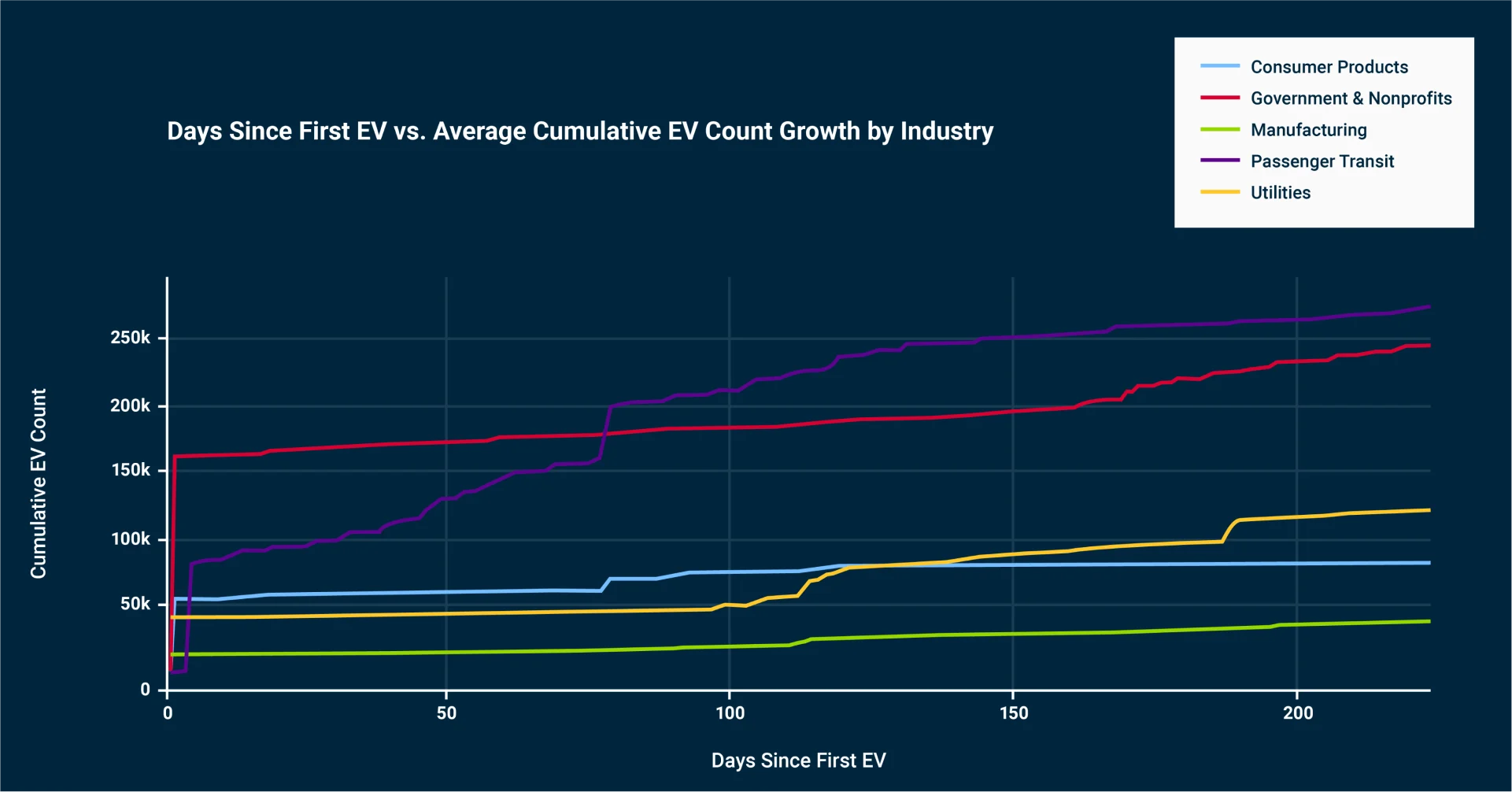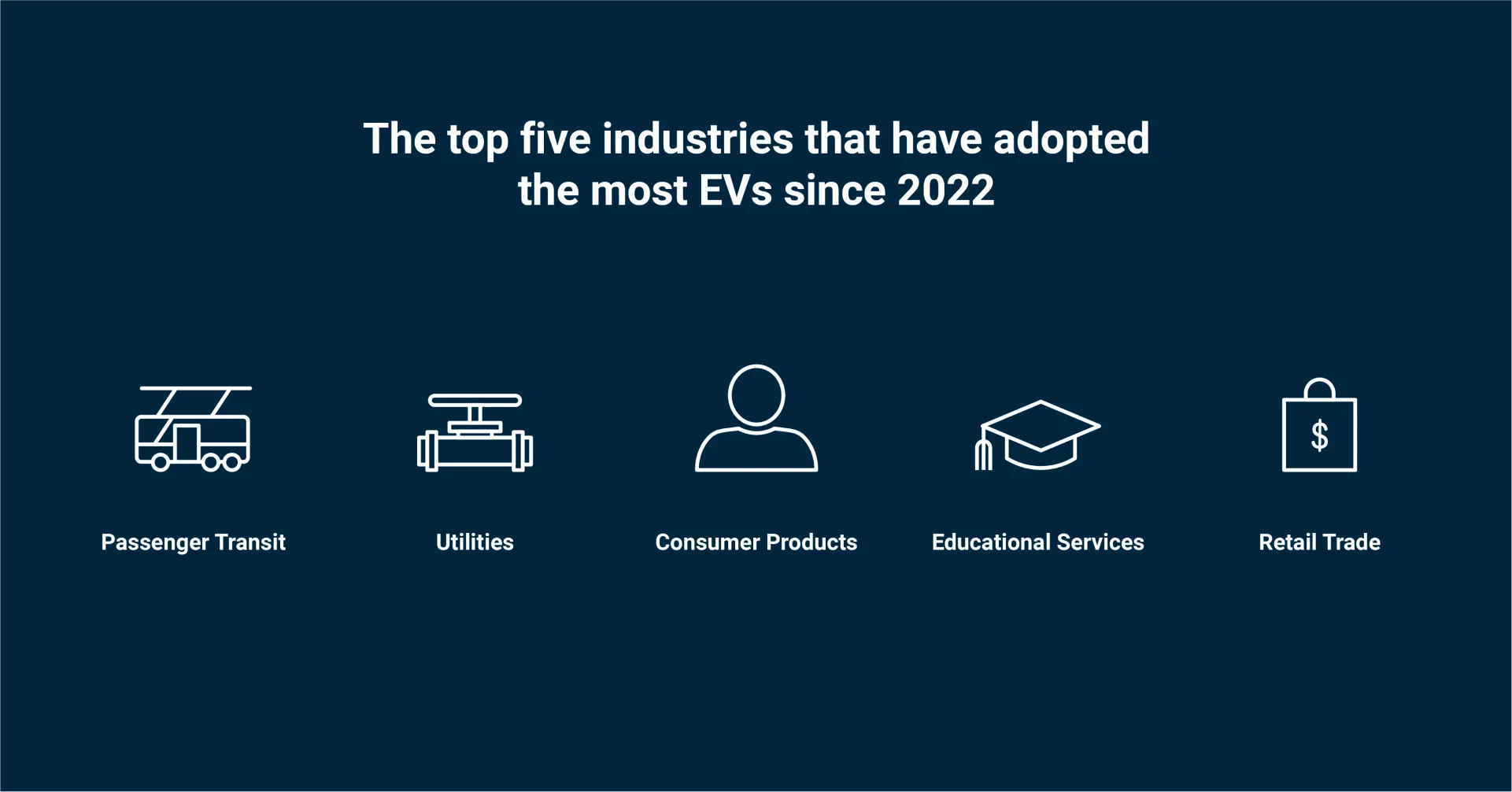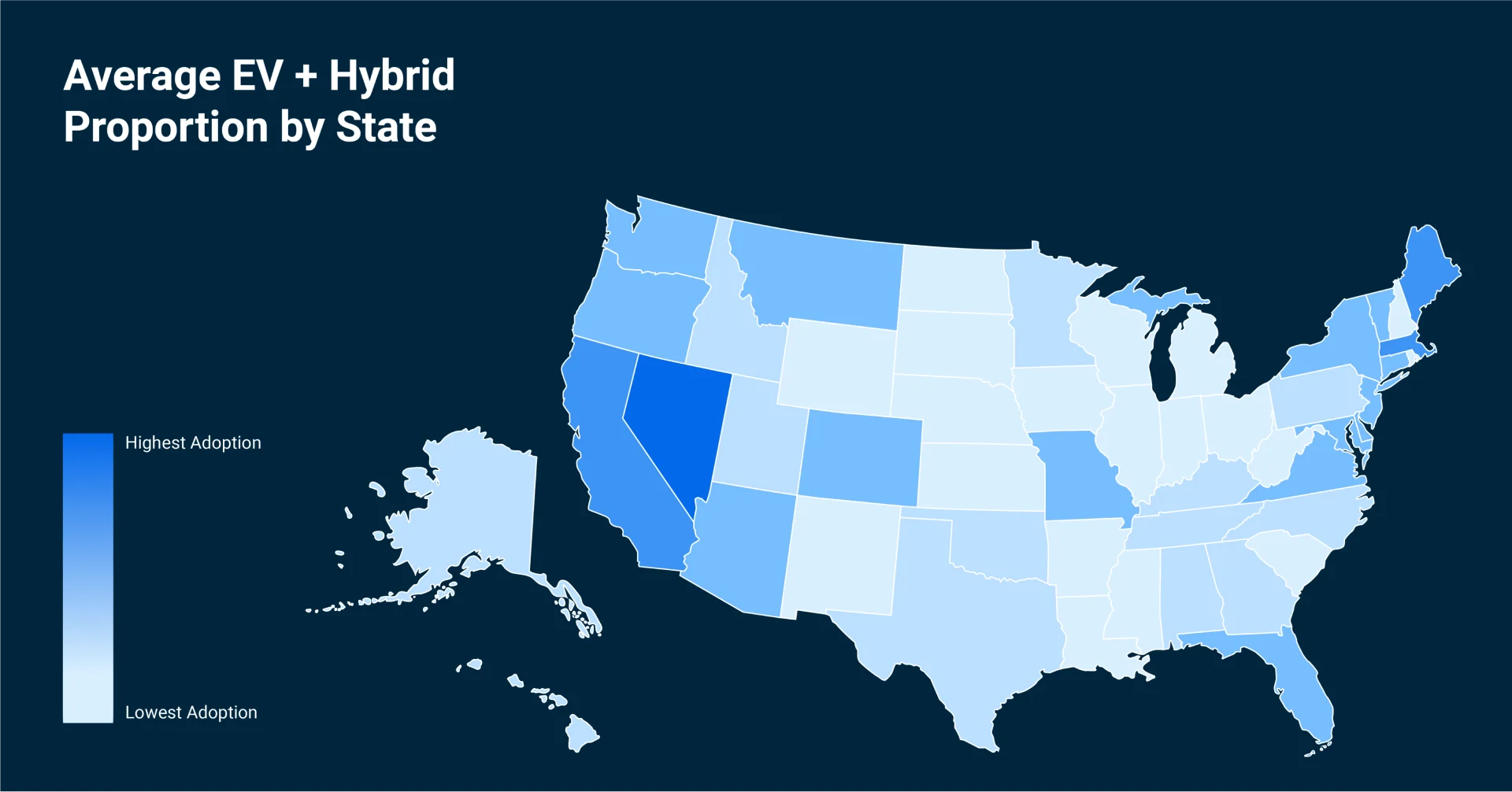Data Insights
Samsara Data Shows Government Agencies Lead the Charge on EV and Hybrid Adoption
April 22, 2024
Senior Applied Scientist

Get the latest from Samsara
Subscribe nowFuel economy is always a top priority for fleets, and recent factors—such as persistently high inflation—have ratcheted up the focus on optimizing the use of fuel and lowering costs. In fact, fuel prices are the third most cited issue in the 2023 Top Industry Issues report from the American Transportation Research Institute (ATRI). Moreover, the ATRI report found that the cost of fuel rose to 28% of a truck's total operating costs, the highest percentage since 2014.
Fleets are tackling the issue in a variety of ways. In addition to physical factors—such as aerodynamic mirrors, cab insulation, and nitrogen-filled tires—technology is playing a critical role in improving fuel efficiency. Looking at one cohort of thousands of Samsara customers*, for example, we found that they realized a 1.2% decrease in mean gallons of fuel per mile during their first year.
That number may seem small, but multiplying it across entire fleets can quickly add up to significant savings. For example, consider a fleet of 500 semi-trailer trucks traveling the industry average of 62,169 miles a year. Over 12 months, the fleet has the potential to save 54,910 gallons of fuel, or about $223,000 (assuming a diesel price of $4.00 per gallon and an average MPG of 6.68).
Fleets are also turning to electric vehicles (EVs) to take their fuel economy efforts to the next level, as well as support their sustainability initiatives. According to a recent Samsara report, 99% of physical operations leaders surveyed have already implemented or plan to implement a sustainability program, while 85% have said that increasing the sustainability of their operations is a high or critical priority. As a result, nearly half (49%) have accelerated their transition to EVs.
We wanted to dig beneath the surface of these trends and get a better sense of which industries and geographies are leading the way in fleet electrification. To do so, the Samsara Data Science and Analytics team examined EV and hybrid vehicle adoption data from a large global customer cohort.** Read on to see what we discovered.
Government & Nonprofit take the top spot for industry adoption.
Within Samsara’s customer base, the industry with the highest proportion of EVs in their fleets is Government & Nonprofit—which includes organizations such as municipalities and charities that make deliveries—followed by Utilities and Consumer Products. Manufacturing and Passenger Transit round out the top five.
Government & Nonprofit
Utilities
Consumer Products
Manufacturing
Passenger Transit
Why these industries in particular?
The top industry, Government & Nonprofit, is an example of how clear policies and incentives can lead to significant EV adoption. Government agencies and nonprofits often have well-developed programs and goals for sustainability, technology investments, and public health—among other initiatives—that strongly align with the benefits of EVs.
In addition, some governments have implemented regulations or incentives to promote EV adoption, such as zero-emission vehicle mandates or tax incentives for EV purchases. Government agencies may be required to comply with these regulations or may benefit from associated incentives, further driving EV adoption.
Moreover, our data shows that EV adoption is much higher for organizations that drive fewer total miles, a factor that many of these industries may have in common. For example, municipal vehicles may only need to drive within city limits to serve constituents, or an electric utility provider may only need to drive within a defined area to maintain its services. These organizations may also operate in locations with more charging stations and better EV infrastructure.

Stories behind the data: The City of Boston
The City of Boston has a goal to fully electrify their fleet by the year 2030, and has made a sizable investment in EVs to support the transition. As a start, the City purchased eight fully electric light-duty vehicles and 14 plug-in hybrids to include in their municipal vehicle-sharing program. In addition, the City’s code enforcement team uses the EVs to inspect snow and trash removal, as well as city code compliance.
These EV investments, combined with Samsara technology, have helped the City to eliminate 513K pounds of CO2 emissions and save an estimated $86K in fuel spend across 18 vehicles.
We also looked into which industries have adopted the most EVs since 2022. This more recent list is somewhat different, with Passenger Transit jumping to the top spot and Educational Services moving onto the list.
Passenger Transit
Utilities
Consumer Products
Educational Services
Retail Trade

While it’s difficult to pinpoint the exact reason why these industries have recently boosted their EV adoption, one factor that might be seen as contributing to this trend is the U.S. government’s recent investment in transportation and infrastructure. In sectors like Passenger Transit, federal regulators have recently focused on incentivizing the increased adoption of EVs. For example, under the Inflation Reduction Act, businesses and tax-exempt organizations that buy qualified commercial clean vehicles could qualify for a clean vehicle tax credit of up to $40,000 (for vehicles larger than 14,000 pounds). In addition, the Infrastructure Investment and Jobs Act, signed into law in 2022, set forth funding for EV-related grants, such as the EPA's Clean School Bus Program, a potential catalyst to drive EV adoption in the Education Services sector.
Nevada and California are the top states for EV and hybrid adoption.
In addition to industry, it's interesting to consider which states have the most EVs and hybrid vehicles. According to our data, the top five states are Nevada, California, Massachusetts, Maine, and Arizona.

Each one of these states has multiple public and private incentives aimed at driving EV adoption, with varying refunds, grants, and exemptions. For example, Nevada and Massachusetts both offer grants to mitigate diesel emissions, while California and Maine offer rebates to businesses that purchase EVs. Arizona offers businesses rebates for the purchase or lease of electric forklifts, truck charging bays, and other electrification projects.
The number and variety of electrification incentives indicate that federal, state, and local governments could be a force behind sustainability initiatives. However, the number of incentives does not appear to dictate the volume of EVs on a state's roads today. For example, Nevada has far fewer incentives than California—six versus 92, respectively—but Nevada still ranks first in our list of states with the most EVs.
The United Kingdom shows a clear path for the successful transition to EVs.
EV adoption is growing in the United States, but American organizations are playing catch up to businesses and governments across Europe. It’s a trend we see reflected in Samsara data. For example, we looked at customers across the United Kingdom and found some significant differences. Notably, average EV and hybrid adoption per organization in the United Kingdom was about three times higher than in the United States.
Moreover, within our customer base in the UK, the highest proportion of EV and hybrid adoption is in the Consumer Products industry, a category that includes car rental companies, catering companies, and other organizations related to consumer goods and services.
Stories behind the data: Otto Car
For Otto Car, the largest electric private hire fleet in Europe, electrification is critical to the health of their customers and their community of drivers. "4,000 deaths each year in the capital can be [attributed] to London’s poor quality air," writes Otto Car's Senior Marketing Manager, Richard Tester. "As London’s largest [Public Carriage Office] car rental company, we knew we had to play our part and help accelerate the transition from diesel and hybrid to fully electric PCO cars," he says.
To help accelerate adoption, Otto Car offers their drivers incentives to purchase EVs through the Uber Clean Air Plan. Tester explains: "Our goal is to help [drivers] to transition to EVs so they can contribute individually to improving the air in the communities and help all our parents, siblings and children breathe clean air."
Even though the US and UK are different in several ways—the size and population density across each region is significantly different, as is the driving culture—US-based organizations can look to the UK for best practices to boost EV and hybrid adoption, with long-term strategic planning for fleet electrification among them.
Advice for jumpstarting fleet electrification.
In the journey to fleet electrification, clear leaders across industries and regions are already emerging. However, there is still ample opportunity to take advantage of the benefits of EVs and hybrid adoption.
For organizations that haven't begun to make the transition to these vehicle types, however, knowing where to begin can be difficult. "[O]ut of the gate, the thing I would say is, you've got to start somewhere. Don't be overwhelmed,” explains Shawntell Kroese—Assistant Vice President of Sustainability and Sales Operations at Werner Enterprises—in a recent interview with HDT Talks Trucks. A Samsara customer, Werner is one of the largest transportation and logistics companies in the US with more than 8,500 trucks, 27,000 trailers, and 14,000 associates.
To jumpstart their efforts to reduce emissions, Werner turned to their customers. As Kroese explains: "One of the things that we looked at was, what are our customers using, right? When we read their corporate social responsibility reports, what are they caring about? And I think it helps make that connection as you start talking with your customers, having similar ways that you're holding yourself accountable."
For more best practices on how to get started with EVs, you can explore and download Samsara’s ebook “How to Build Your Electrification Strategy” by visiting our guide here.
Methodology
*Fuel Efficiency Results: A cohort of thousands of Samsara customer organizations that deployed Samsara Vehicle Telematics and Samsara AI Dash Cams were evaluated. We assessed the cohort’s fuel efficiency in their first month and in their 13th month of adoption to discover the percentage increase in fuel efficiency.
**EV and Hybrid Adoption Results: Millions of vehicles across a cohort of thousands of Samsara customer organizations globally were evaluated in March 2024. We assessed primary and secondary fuel types, electrification levels, and applied business logic for specific makes and models to identify electric and hybrid vehicles.
Get the latest from Samsara
Subscribe now











